Milan Fashion Week S/S 2024: Prada to Bottega Veneta
All the Milan Fashion Week S/S 2024 highlights in Wallpaper’s round-up – including the unveiling of Gucci’s new chapter under creative director Sabato De Sarno
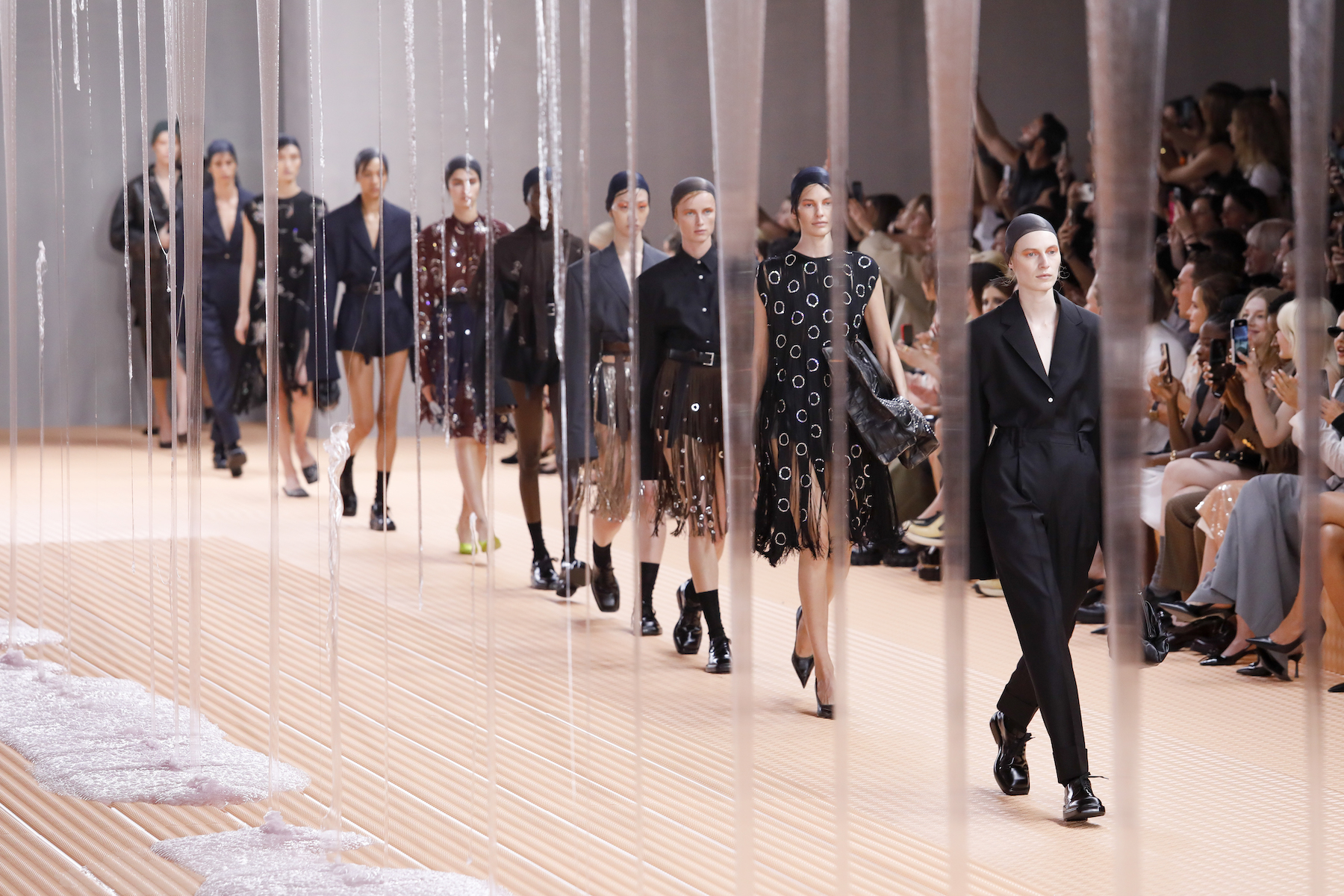
Milan Fashion Week S/S 2024 arrived in the Italian fashion capital last week with a typically packed schedule, though despite the plethora of shows, presentations and happenings across the city all eyes were on Gucci which unveiled its latest chapter under new creative director Sabato De Sarno, formerly of Valentino, who presented a collection inspired by ‘the joy of life’. Also making his debut was Peter Hawkings at Tom Ford – a tenure that began with a blessing from the eponymous founder himself, who worked with Hawkings at the label before his exit earlier this year.
Elsewhere, an array of Italian houses showed their latest collections – among them Prada, Dolce & Gabbana, Bottega Veneta, Ferragamo, Fendi, Giorgio Armani, and more – with the week culminating in the Camera della Moda Sustainable Fashion Awards at La Scala Theatre on 24 September. On the afternoon of the same day, Brazil-born, London-based designer Karoline Vitto – who previously showed with Fashion East – made her Milan debut, presenting with the support of Dolce & Gabbana.
Here, the best of Milan Fashion Week S/S 2024, as it happened.
Best of Milan Fashion Week S/S 2024
Giorgio Armani

Giorgio Armani S/S 2024
‘Vibes’ read the invitation for Giorgio Armani’s latest collection, presented in the house’s Via Borgonuovo headquarters in central Milan on Sunday afternoon. ‘Everything vibrates: colours, sensations, and feelings,’ the designer elaborated via the collection notes. ‘This season, vibrations become visible. They run across entire surfaces in undulating movements and rippling weaves.’ As such, it felt like a sequel of sorts to the Emporio Armani show earlier in the week, where the designer had spoken of a desire for lightness and fluidity reflected in aqueous fabrications and languid forms. Here, he conjured an equally ethereal collection which combined undulating silhouettes – one jacket had 3D waves running across its surface, while silk dresses and pleated trousers gently rippled across the boy – with hazy, dreamlike prints. Mr Armani was at his most liberated, though, in the stream of evening wear which closed the show: lightweight diaphanous layers of organza met shimmering tassels, extraordinarily detailed sequin and bead embroidery, and a mass of crystal adornment which caught the light. ‘Giorgio Armani’s vision refracts and mutates as though passing through a prism,’ said the house.
Bottega Veneta

Bottega Veneta S/S 2024
Anticipation was high for Matthieu Blazy’s fourth collection for Bottega Veneta, which marked the first outside of his opening ‘trilogy’ of shows. That trilogy had been inspired by Bottega Veneta’s native Italy and its dress codes, observed through what Blazy called ‘the alchemy of the street’; this season, presented on a vast tiled map of the world – complete with illustrations of penguins, sardines, crabs and roosters – Blazy looked further afield. It was a collection about travel, real and imagined, a rich ‘odyssey’ in which the designer imagined his protagonist picking up elements of inspiration on journeys around the globe. ‘An odyssey: a journey that is both free and hopeful,’ he described. ‘A connection to who you once were, who you would like to be and where you want to go. The odyssey is both external and internal, physical and through the imagination. It is a journey of transformation and escape.’
It led him back to the idea of archetypes. The collection began with the holiday-goer: a model clad in a knitted swimsuit, carrying a rope-like woven beach bag slung with a pinstripe shirt on top, before moving through an array of travellers – from the corporate commuter (‘dreaming on a train’) to what Blazy called the ‘castaway’, imagined in the homespun craft of extraordinary woven dresses, including those adorned with enormous raffia pompoms which closed the show. What is always striking about Blazy’s work is its sheer generosity – his collections are like an endless stream of elements, each painstaking in its construction – and the undeniably emotional way that the designer works. Like travel, he invites wonder. ‘It’s like collecting seashells – beautiful, meaningful or meaningless,’ he explained of the collection. ‘It is linked to the beauty of small marvels and natural wonders. It’s embracing something freeform: these are clothes without codes.’
Jil Sander
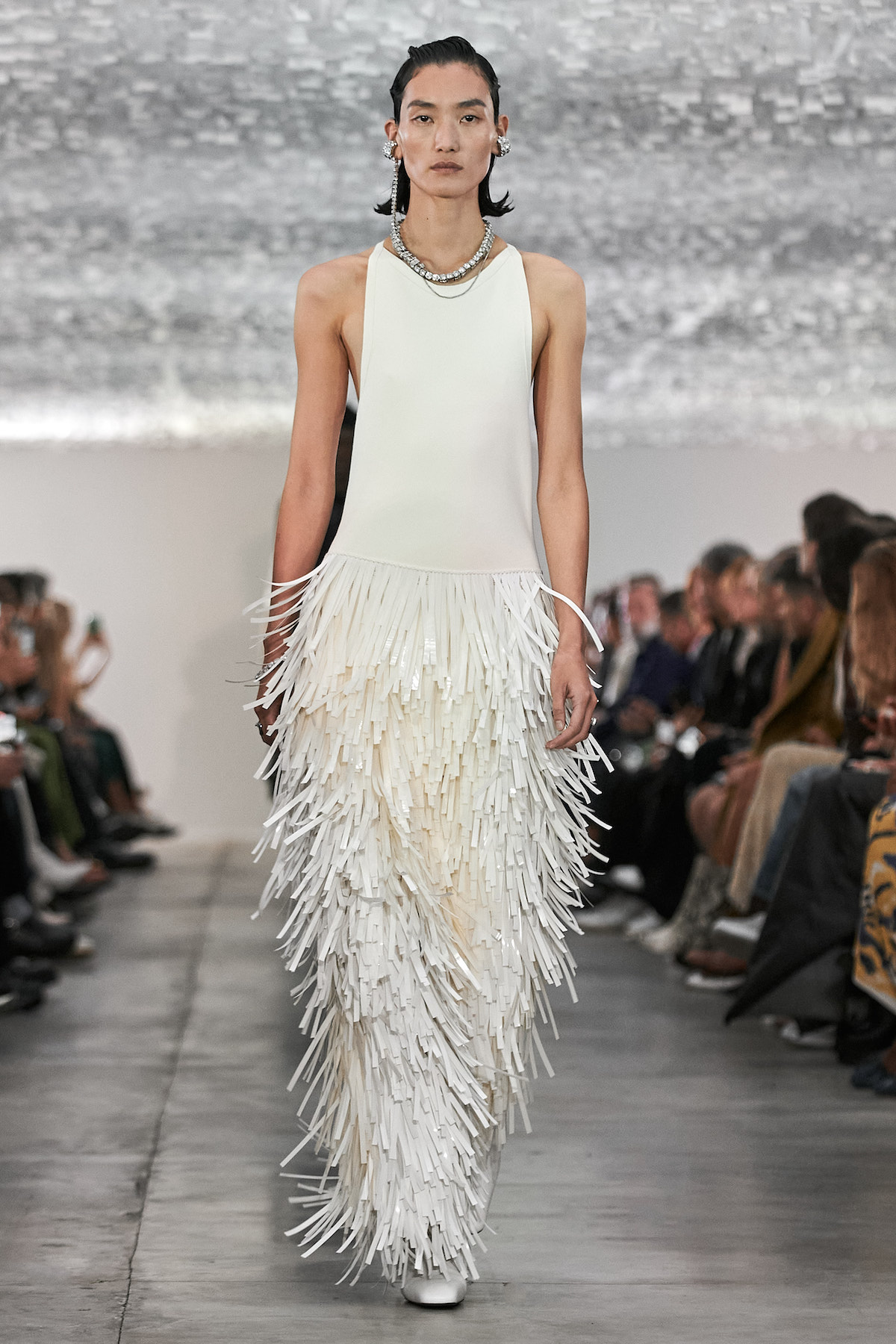
Jil Sander S/S 2024
The hundreds of streamers which hung from the ceiling of the Jil Sander show set, housed in a warehouse on Milan’s outer reaches, hinted at a mood of celebration. Indeed, in the flourishes of crystal jewellery – which adorned almost every look, both men’s and women’s – as well as suggestions of ball gowns and tuxedos, there was undoubtedly a desire for dressing up from Lucie and Luke Meier this season. It continued the wife-and-husband duo’s departure from the house’s minimalist codes, though there is no doubt still a simplicity and clarity to their approach: a particular highlight was a series of dresses with a ribbed knit top and fuller contrasting skirt, which riffed on classic haute couture silhouettes in contemporary style. Their desire for textural richness also continued this season: paillette-adorned skirts and tops made a gentle clatter as they walked down the runway, while iridescent silks and glossy fabrications lent moments of shine.
Wallpaper* Newsletter
Receive our daily digest of inspiration, escapism and design stories from around the world direct to your inbox.
Dolce & Gabbana

Dolce & Gabbana S/S 2024
Domenico Dolce and Stefano Gabbana continued to mine house codes in a collection titled ‘Woman’ which looked towards the construction of underwear for inspiration, a longtime reference for the designers, whose work has often included elements of underwear and corsetry. Rendered largely in black and white, body-contouring sheer dresses revealed intricate lace underwear beneath, while riffs on stockings (including a new flat pointed boot pulled on like tights) were designed to recall the women of ‘old Sicily’. Elsewhere, the designers struck an astute balance between tailoring – largely wide-shouldered and inspired by the cut of a tuxedo jacket – and flou, which came in floating layered polka dot dresses or voluminous sheer organza blouses. The designers called it ‘a new female image of extreme sensuality’, perhaps best epitomised by two of the house‘s perennial muses, Mariacarla Boscono and Naomi Campbell, who both walked the show.
Ferragamo
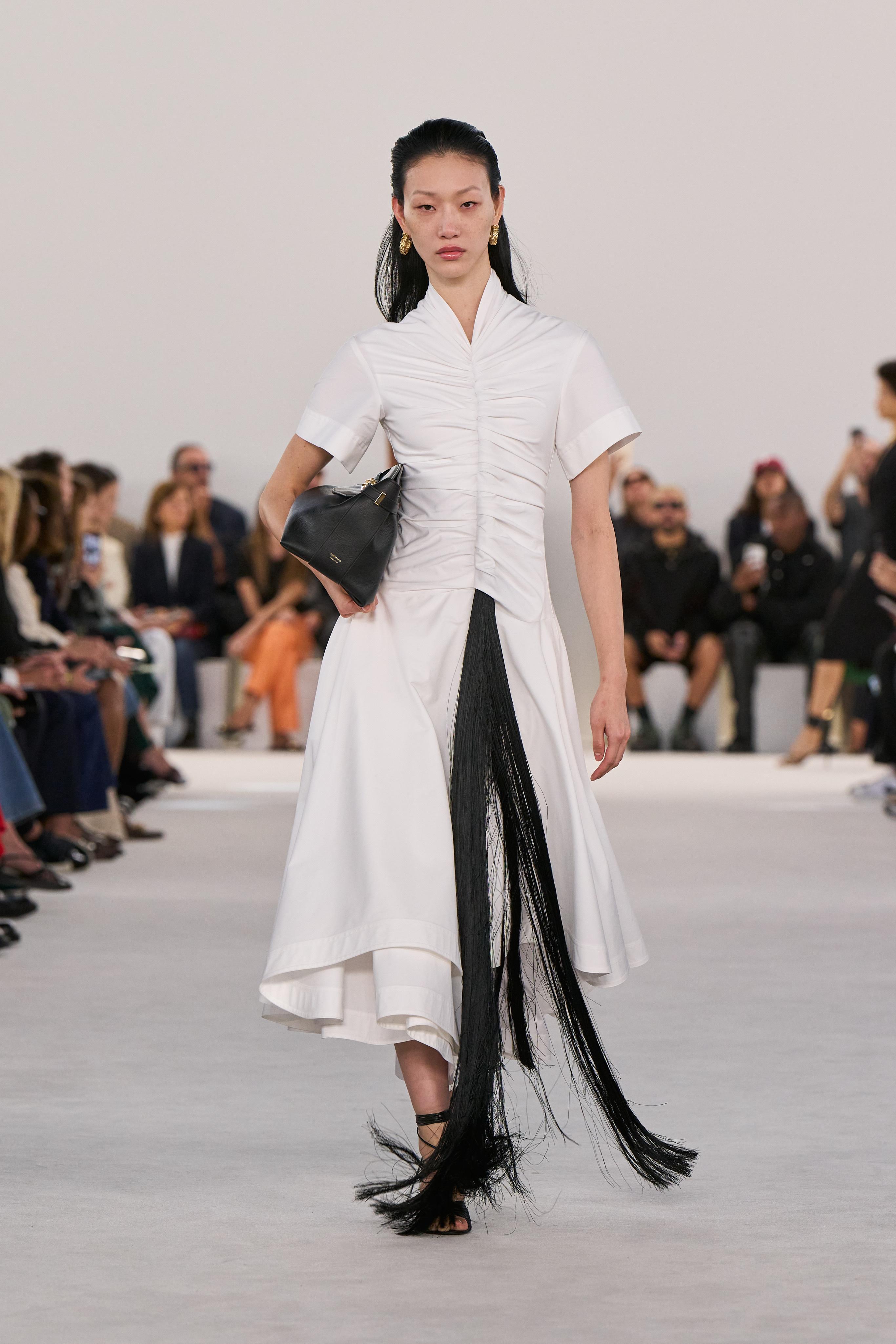
Ferragmo S/S 2024
Maximilian Davis hit his stride this season at Ferragamo with a supremely elegant collection the British designer said was about finding a feeling of effortlessness inspired by both Italian style and his own Caribbean roots. ‘I wanted things to feel a lot lighter, both in terms of fabric and construction but also in terms of how people want to dress,’ he said. ‘There’s a familiarity I have found in the Italian way of dressing and living: an effortlessness which feels very Caribbean. The idea of doing everything at your own pace, on your own time.’ This idea of lightness and ease ran throughout the collection, which had a fluidity previous seasons occasionally lacked: beautiful viscose jersey gowns were overlaid with structured leather bodices (a nod, he said, to Renaissance armour), oversized trench coats gently enveloped the body, while narrow tailoring – for men and women – had an opposing strictness. Elements of craft also featured more than in previous seasons, which Davis said was inspired by Italy’s Arte Povera movement and its desire to use humble materials to elevate the everyday; here, a dress and wide belt appeared crafted from miniature floor tiles. An expansive array of bags and shoes, from a luxurious triple-zip weekend bag to a vertiginous curved-heel pump, were particularly appealing. ‘I really wanted the pieces to feel very pure and honest,’ he said. ‘For the collection to be relatable within a wardrobe, but interesting in terms of the touch of the hand.’
Versace

Versace S/S 2024
After decamping to Los Angeles last season to show during Oscars week, Donatella Versace made her return to Milan with a typically blockbuster show staged on a gleaming checkerboard runway surrounded by floating floor-to-ceiling curtains. The checkerboard motif ran throughout a collection the charismatic designer called ‘fresh and graphic’, recalling the 1960s in its abbreviated mini dresses, prim cardigans and hair bows and bands, as well as boxy suiting adorned with golden Versace buttons. A contrast came in draped, Grecian style gowns – cut with Versace’s near-inimitable eye for accentuating the body and its silhouette – worn here by model Gigi Hadid in her first appearance of the week. ‘I love the contrast between boxy suits and the transparency of an evening dress,’ said Versace, who also drafted Claudia Schiffer – a longtime house muse – to make her own runway return, wearing a chainmail checkerboard dress accessorised with knife-point metallic pumps.
MSGM
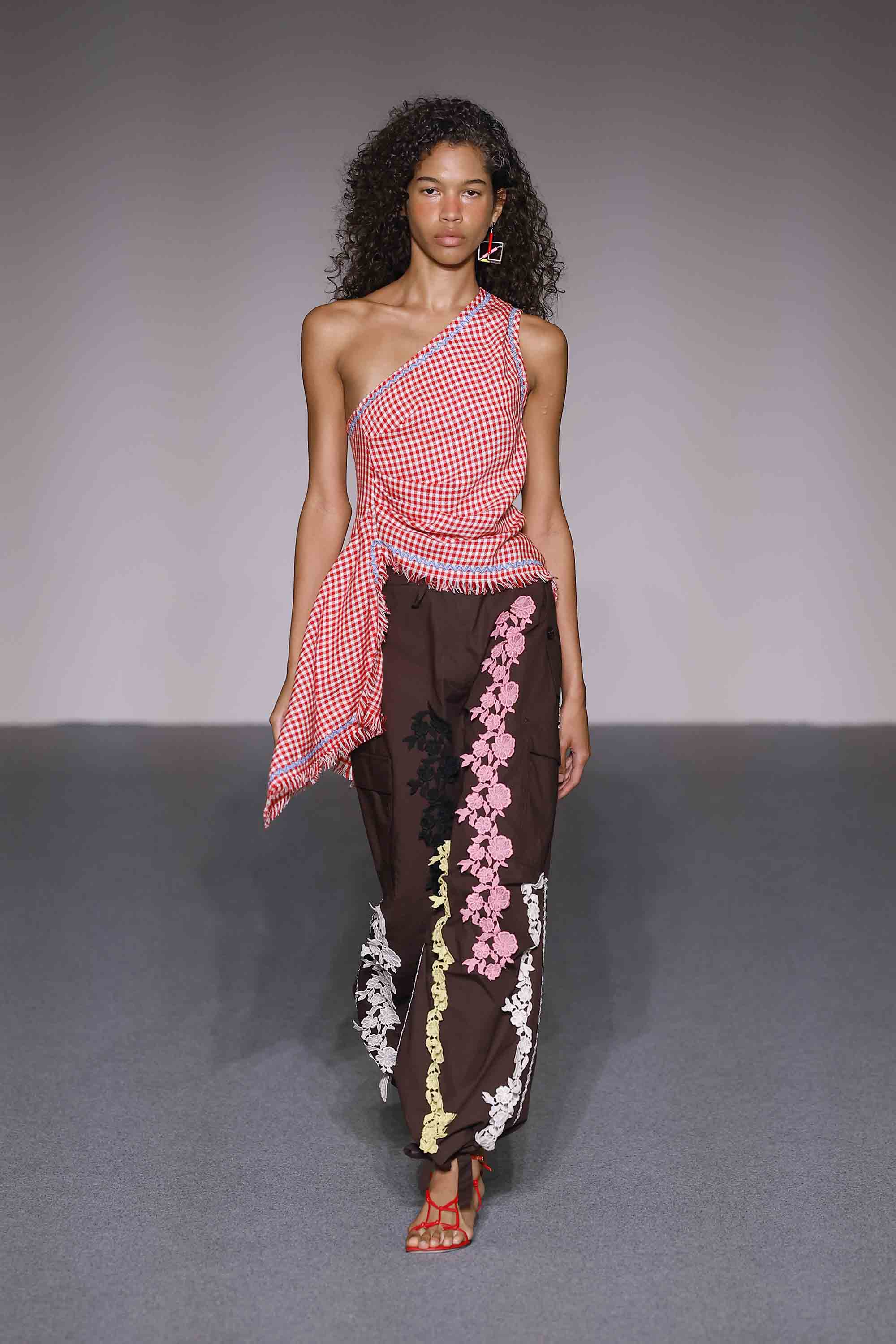
MSGM S/S 2024
There is always a refreshing levity to Massimo Giorgetti’s collections for MSGM, a mood of experimentation and play which continues to distinguish the designer in a busy Milan schedule. This season, he spoke of ‘a new rhythm’ defined by ‘unpredictability and randomness’ that he likened to straying off life’s beaten track. As such, there was a feeling of collage to the eclectic collection: checkered tailoring and bubble-hem dresses twisted and tied around the body, adornment spanned naive floral prints, stitched-on tassels and beaded embroidery, while poppy shades of lemon yellow, lavender and a pink he described as ‘taffy’, ran throughout. ‘Overwhelming and liberating,’ said the designer, who soundtracked the collection with the pulsating sounds of The Normal’s ‘Warm Leatherette’.
Gucci

Sabato De Sarno called his first Gucci collection ‘Ancora’, translated by the house into English as ‘now, also then’. The phrase – which had already appeared on billboards around the world prior to the show – spoke to De Sarno’s desire to translate elements from the house’s archive into the present-day (particularly its signature Jackie and Bamboo handbags), but also to create ‘the opportunity to fall in love with fashion, ancora,’ as he described. A departure from his predecessor Alessandro Michele’s theatrical collections for the house, De Sarno focussed on pragmatic clothing inspired by the city’s streets (originally, the show was meant to have taken place on the pavements of Brera, before rain saw the show shifted to the Gucci Hub) nonetheless infused with moments of glamour and craft associated with Gucci. As such, riffs on wardrobe archetypes – the tank top, the hoodie, jeans, tailoring – met crystal-adorned baby doll dresses or outerwear overlaid with glimmering metal tassels. The collection also saw the introduction of ‘Ancora Rosso’, an oxblood-style shade of red which recurred throughout, and took its inspiration from the interiors of London’s Savoy Hotel (founder Guccio Gucci worked as a bell boy there prior to beginning the house). ‘It’s a story of joy of life, of passion, of humanity, of people, of real life, of irreverent glamour, of provocation, of confidence, of simplicity, of immediate feelings and emotions,’ explained De Sarno. ‘It’s a story of everything, again, but this time expressed through joy.’ Read our full report here.
Sportmax

Sportmax S/S 2024
The Sportmax show space was divided down its centre by a fluorescent-lit glass vitrine in which a jungle of tropical flowers and plants grew. ‘The cyclical battle between tradition and progress,’ was how the brand described the collection, which provided an echo of the strange, science-fiction-style backdrop: almost entirely in white, experimental padded forms met sculptural twists of organza and high-neck shift dresses which recalled medical uniforms. The design team behind the collection said they were seeking a feeling of simplicity, looking towards Japan for inspiration; here, this emerged in dresses cut with kimono necklines, or bandeau tops evocative of the traditional obi-belt. Prints, meanwhile, were drawn from the ‘Postnaturial’ works of Czech artist Krištof Kintera, who is known for creating dystopian imaginings of botanical herbariums – the central inspiration behind this intriguing, futuristic collection.
Tod’s

Tod’s S/S 2024
Walter Chiapponi’s final collection for Tod’s was housed in a vast industrial space used by Milan’s Teatro alla Scala to construct the sets for its operatic performances. The Teatro’s artisans are currently creating the set for an upcoming performance of ‘Don Carlos’, seeing the space filled with intricate pieces of mise-en-scène, from cherub-adorned wood panels and angel wings to enormous painterly backdrops. Chiapponi noted that he selected the space for its resemblance to Tod’s’ own workshops; indeed, around the show set the house’s artisans had been drafted to work on footwear and accessories by hand. The collection itself was defined by a feeling of lightness and ease, infused with the mood of 1990s minimalism which has defined the designer’s tenure at the house so far. Languid trench coats sat over gently oversized tailoring, while simple cotton poplin tops were given shape with leather utility belts. Elegance came in beautiful, lightweight leather skirts – a demonstration of Tod’s commitment to made in Italy craft – or the simple, unadorned handbags and leather mules. To close the show, Chiapponi looped the runway in an emotional final lap, while talk spread that his successor will be announced before the year is out. ‘I wanted to say goodbye with beauty,’ he said.
Blumarine

Blumarine S/S 2024
‘I wanted to emphasise the luminous sense of lightness of the summer season,’ said Blumarine creative director Nicola Brognano, a mood reflected in the sparse white show space – an opposition to February’s runway, which was covered in heaps of moss and mud. That is not to say the collection was stripped back – Brognano continues to mine poppy 2000s style for inspiration, from glimmering embellishment and butterfly motifs to sinuous, barely-there silhouettes – though there was a feeling of levity to the seasonal palette, which spanned optic white, gold, and a series clear fabrics which exposed the models’ bodies beneath. Adding to the mood of lightness was a series of looks worn with enormous white feathered angel wings, while the drape of jersey dresses was almost Grecian in design. Brognano’s signature butterfly motif also reappeared in sensual style throughout, adorning a pair of glimmering thong underwear or spreading its sequin-adorned wings across the chest of a dress. ‘Clear, limpid colours; slim silhouettes,’ Brognano explained. ‘The body is tight-wrapped, but it moves freely. Sensuality is expressive, strong, modern, natural, with no romanticism.’
Prada

Prada S/S 2024
After the show, Miuccia Prada – who co-creates the collections alongside Raf Simons – drew attention to one of the collection’s handbags, a ruched evening bag with a clasp depicting the head of a mythological figure. She noted that the design was not new, but over a century old, first designed by her grandfather Mario Prada – the founder of the eponymous house – in 1913. The ruched evening bag, originally rendered in silk moiré, here in nylon, spoke to the mood of the collection, which referenced Prada’s deep-rooted history craft – the house was built on its creation of leather steamer trunks and handbags – something Simons said is not often talked about in the house’s collections, though is ever-present. ‘Although we usually don’t, for this season we wanted to talk about the craftsmanship – the complexity of work in these clothes. All the embroideries are by hand, and throughout there are ideas and techniques we have studied and developed over a long period,’ he noted. ‘This work is always part of what we do, have always done. We wanted to recognise it here.’
As such, the collection was one of material richness: diaphanous dresses, rendered from a translucent fabric so lightweight Prada purportedly patented the technology, seemed to float on air, while glimmering tassels, intricate embroidery, and eyelets which dotted shirts and dresses ran throughout. An echo of the menswear tailoring shown this past June –whereby the pair sought to apply the white shirt’s feeling of ‘lightness, ease and comfort’ to simple blazers – came in lightweight suiting which referenced 1940s silhouettes in its narrow tucked-in waist and wide shoulder. The curtains of Alien-like slime also returned from the menswear show, dripping from the ceiling onto the stainless steel runway, lending a typically Prada-esque mood of subversion and disorientation to the collection’s ladylike looks. ‘Recognised ideas, techniques and materials are used differently, approached in uncommon ways… shifting things, pushing things,’ said Simons. ‘We tried to make the best out of our work, to make beautiful things, for today,’ added Prada. ‘That may sound banal, but it is the truth.’
Emporio Armani

Emporio Armani S/S 2024
Giorgio Armani was thinking about the idea of lightness at Emporio Armani, continuing his decades-long exploration of the fluidity of clothing: how a garment can encompass both elegance and ease, be adorned with elements of craft and embellishment without ever feeling cumbersome. Shown at the house’s Armani Teatro – which in recent seasons has become a circular runway, so that the collections can be seen in the round – the designer described the collection to feel as if it picked up on a gentle summer breeze. It was a mood perhaps best encapsulated by the 12 closing looks, whereby diaphanous layered organza skirts and dresses were adorned with delicate, almost aqueous embellishments of sequins, crystals and shimmering paillettes (headscarves and stacks of cuffs and jewellery were worn alongside). ‘Everything flows lightly, like a breeze,’ said the house of these pieces, which came at the end of a typically rich expansive offering from the designer, whether the array of elegant tailored jackets – cut with the fluidity of line which defines Armani’s work – sportier bombers and luxurious iridescent tracksuits, or gently flared mini dresses. As ever, the show ended with a rapturous reception for the designer, who despite turning 89 earlier this year, shows no sign of slowing down.
MM6 Maison Margiela

MM6 Maison Margiela S/S 2024
Recent seasons have seen MM6 Maison Margiela hitting its stride, providing a convincing proposition for a real-world wardrobe that nonetheless retains the undone subversion of its eponymous founder Martin Margiela (as such, MM6 – which is designed by an anonymous in-house design team – provides a more grounded counterpoint to John Galliano’s work for the main Maison Margiela label). There has been great oversized tailoring, voluminous jeans and shirts, and plenty of off-kilter footwear to rival the tabi, from a popular riff on the ballet pump to an ongoing collaboration with performance footwear brand Salomon. All these elements were evidenced in this latest outing, which was inspired by ‘the hand… gestures that define pieces of clothing, and items that entice certain postures’. In the collection itself, this meant figured elements that changed the way clothing was worn: elongated T-shirts were sliced along the side allowing their length to be swept sideways under the hand, blazers could be tied with fastenings that ran along their front (playfully, they retained their button holes despite having no buttons), while paper fabrics appeared to have been shaped and manipulated through wear. If such elements sound tricky, they were anything but: the gently oversized jackets, worn with billowing wide-leg trousers, an open shirt and vest were at once easy and elegant, while elements of deconstruction – raw hems, netted vests, patchworked leather and denim – recalled the irrefutable spirit of the label and its founder.
Max Mara

Max Mara S/S 2024
In June 1939, Britain’s Land Army was created, an all-female workforce that tended the country’s farms in the absence of men at war. These ‘Land Girls’ – as they called themselves – provided the inspiration for Ian Griffiths’ latest Max Mara collection, a designer for whom empowered visions of womanhood have defined his tenure (previous collections have looked to women artists, thinkers and activists, often lesser-known, for inspiration). As such, clothing mined a 1940s silhouette – gently narrowed waists, wide-cut shoulders – while utility elements, inspired by the Land Girls’ workwear, emerged in apron-style dresses, boiler suits, and jodhpur trousers with combat pockets, as well as the washed patina of the fabric, which appeared as if faded from the sun. A series of floral prints, meanwhile, were inspired by the interiors of Bloomsbury Group author and gardener Vita Sackville-West’s Sissinghurst estate in Kent (she wrote a book about the Land Girls in 1944). But Griffiths’ riff on such historical inspirations was made astutely contemporary in the simplicity of the garments’ cut – he noted that though the reference was ‘pastoral’ he imagined the collection being worn by a woman in the city, laptop in hand – as well as in the broad use of colour, which spanned soft shades of pink, teal green and purple. A slew of easy monochrome eveningwear closed the show, the final look comprising a simple cotton-drill white shirt, floating full-length chiffon black skirt, and a gardener’s-style apron, epitomising the juxtaposition of elegance and utility which ran throughout.
No. 21

No. 21 S/S 2024
The innate contradictions of Naples – No. 21 creative director Alessandro Dell’Acqua’s home city – provided the inspiration for the Milan-based label’s latest collection. ‘The dual soul of Naples,’ the designer reflected, ‘aristocratic and popular souls, culture and carnality, false morality and bold natural sensuality.’ As such, there was a sense of juxtaposition to the collection’s looks, which teetered between the sensual and the demure: an undone bodysuit – revealing a vintage-style bra top beneath – was worn with a bridal-style veil. Sheer, paillette-adorned dresses and skirts revealed simple Y-front cotton underwear, while a translucent organza black mini dress came with a prim white Peter Pan collar. Some of these oppositions, Dell’Acqua said, came from the opposition of wedding celebrations – referenced in white satin swing coats, pointed white pumps and plenty of lace – against the archetype of the Italian widow, here imagined in a slew of dramatic black looks which closed the show. ‘Drama, playfulness, sensuality and levity,’ Dell’Acqua said of the collection, which continued to hone the designer’s intriguing, sensual depiction of womanhood, in all its contradictions.
Fendi

Fendi S/S 2024
Though Fendi provided the opening show of Milan Fashion Week, British creative director Kim Jones had his eyes set on another Italian city: Rome, where Fendi was founded close to 100 years ago, in 1925, and continues to be based. Monolithic versions of the house’s handbags – crafted in sculptural white like ancient antiquity – populated the space, the effect something like walking through the ruins of the Roman Forum. Indeed, Jones said the collection began with his own wanders throughout the city: ‘When I’m in Rome, every day I walk from the hotel to the Colosseum wearing my ear pods. It’s like listening to an imaginary film with Fendi characters I see along the way.’ (The show’s soundtrack was fittingly cinematic, with Max Richter’s soaring ‘On the Nature of Daylight’ mixed with Dinah Washington’s 1960 ‘This Bitter Earth’). He defines such characters as encapsulating a distinctly Roman sense of style: ‘an elegance and ease in not caring’, he described, ‘women who dress for themselves and their own lives’. (He noted Silvia Venturini Fendi and her daughter Delfina Delettrez Fendi, artistic director of accessories and menswear and artistic director of jewellery respectively, as particular examples).
The collection was defined by a feeling of lightness and freedom, epitomised in its vivid palette – slashes of red, orange and lemon yellow ran throughout – and the easy, twisting silhouettes which were designed to recall the drapery of Roman statues. Featherweight ribbed knitwear also returned this season – creating body-contouring dresses with cut-out details – while other intarsia knits were adorned with a colourful graphic of the house’s Double-F logo. Colour-blocking also came in patchwork leather outerwear, or the flapping knit panels on dresses – here in various contrasting hues – which can be wrapped or tied around the waist. ‘[It’s about] not caring what anyone else thinks,’ said Jones of the collection, which had a refreshing feeling of spontaneity and irreverence. ‘It’s not about the spectacle of being looked at but the reality of wearing and the confidence and chicness that comes with it. It’s not about being something but being someone.’
Stay tuned for more from Milan Fashion Week S/S 2024.
Jack Moss is the Fashion Features Editor at Wallpaper*, joining the team in 2022. Having previously been the digital features editor at AnOther and digital editor at 10 and 10 Men magazines, he has also contributed to titles including i-D, Dazed, 10 Magazine, Mr Porter’s The Journal and more, while also featuring in Dazed: 32 Years Confused: The Covers, published by Rizzoli. He is particularly interested in the moments when fashion intersects with other creative disciplines – notably art and design – as well as championing a new generation of international talent and reporting from international fashion weeks. Across his career, he has interviewed the fashion industry’s leading figures, including Rick Owens, Pieter Mulier, Jonathan Anderson, Grace Wales Bonner, Christian Lacroix, Kate Moss and Manolo Blahnik.
-
 Croismare school, Jean Prouvé’s largest demountable structure, could be yours
Croismare school, Jean Prouvé’s largest demountable structure, could be yoursJean Prouvé’s 1948 Croismare school, the largest demountable structure ever built by the self-taught architect, is up for sale
By Amy Serafin Published
-
 A freshly remastered classic Range Rover brings unexpected Italian style to a British icon
A freshly remastered classic Range Rover brings unexpected Italian style to a British iconItalian company Vinile’s Range Rover Classic restomod made its debut at Milan Design Week, showcasing local craftsmanship and engineering updates
By Jonathan Bell Published
-
 Yves Béhar designs a wash basin for Laufen that goes with the flow
Yves Béhar designs a wash basin for Laufen that goes with the flowInspired by the movement of water and to be produced in a CO2-free electric kiln, ‘Volta’ has an innovative circular form
By Ifeoluwa Adedeji Published
-
 Giant cats, Madonna wigs, pints of Guinness: seven objects that tell the story of fashion in 2024
Giant cats, Madonna wigs, pints of Guinness: seven objects that tell the story of fashion in 2024These objects tell an unconventional story of style in 2024, a year when the ephemera that populated designers’ universes was as intriguing as the collections themselves
By Jack Moss Published
-
 Fashionable Christmas baubles to accessorise this year’s tree, from Bottega Veneta to Loewe
Fashionable Christmas baubles to accessorise this year’s tree, from Bottega Veneta to LoeweSelected by the Wallpaper* style team, a gleaming array of Christmas baubles for fashion fans featuring fantastical designs from Bottega Veneta, Loewe, Prada and more
By Jack Moss Published
-
 ‘He made something not merely popular, but the rage’: unpacking Elio Fiorucci’s fabulous fashion legacy
‘He made something not merely popular, but the rage’: unpacking Elio Fiorucci’s fabulous fashion legacyAn expansive new retrospective at Triennale Milano explores the colourful life and work of Elio Fiorucci, who is synonymous with 1970s hedonism and glamour
By Zoe Whitfield Published
-
 How fashion designer Ilenia Durazzi designed her ‘elegant, rigorous’ Milanese studio – all the way down to the furniture
How fashion designer Ilenia Durazzi designed her ‘elegant, rigorous’ Milanese studio – all the way down to the furnitureIlenia Durazzi of Durazzi Milano tells Wallpaper* the story behind her new Milanese studio, a labour of love built entirely to her exacting design
By Jack Moss Published
-
 Gucci’s ‘Blondie’ bag revival sees the enduring 1970s accessory reimagined anew
Gucci’s ‘Blondie’ bag revival sees the enduring 1970s accessory reimagined anewFirst shown at Sabato De Sarno’s Gucci Cruise 2025 show in London, a new iteration of Gucci’s beloved ‘Blondie’ bag fuses 1970s insouciance with a crisp modernity
By Jack Moss Published
-
 The breathtaking runway sets of S/S 2025, from beanbag animals to a twisted living room
The breathtaking runway sets of S/S 2025, from beanbag animals to a twisted living roomWallpaper* picks the best runway sets and show spaces of fashion month, which featured Bottega Veneta’s beanbag menagerie, opulence at Saint Laurent, and artist collaborations at Acne Studios and Burberry
By Jack Moss Published
-
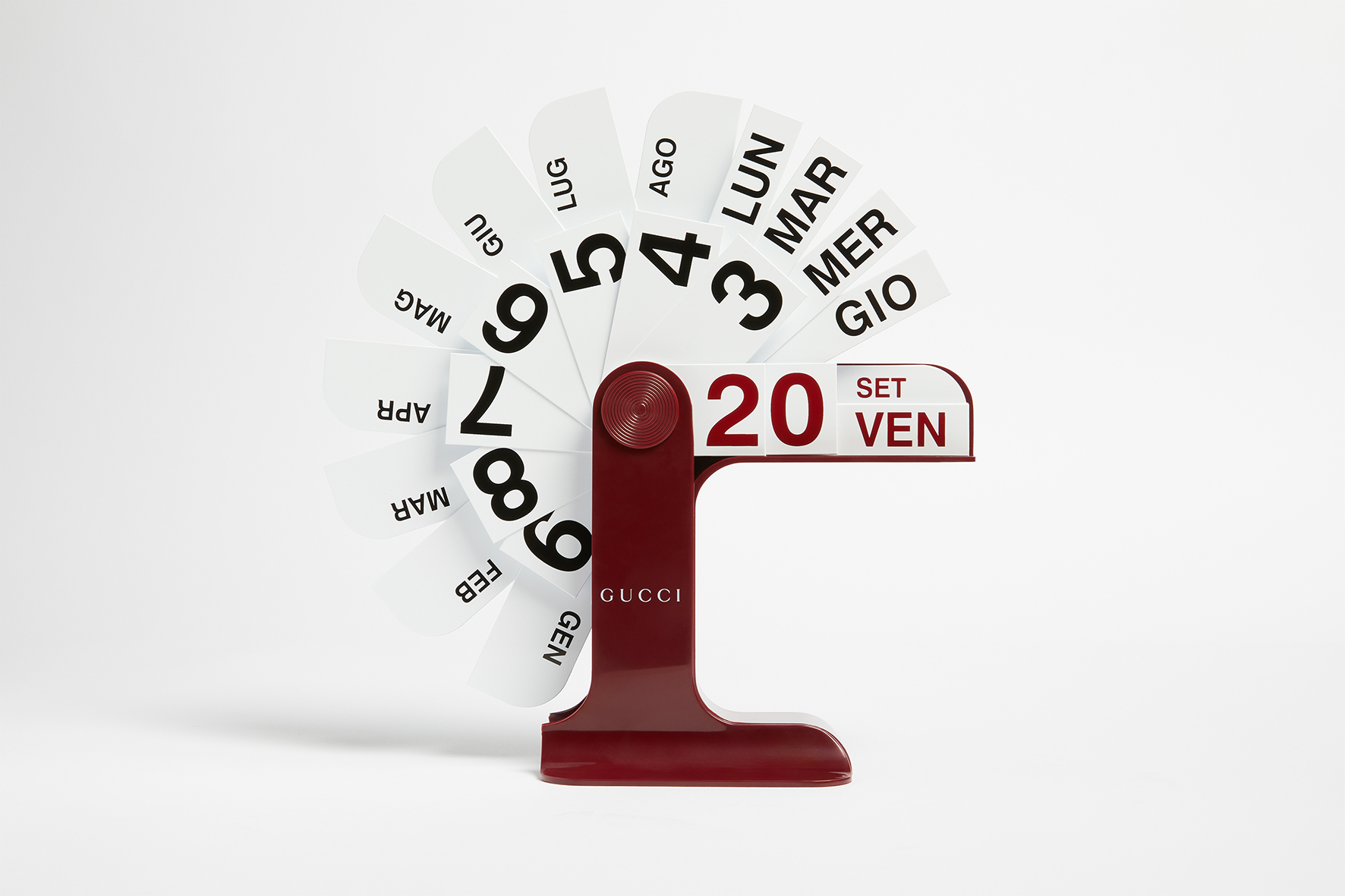 The invitation for Gucci’s latest show was a reissued Enzo Mari design classic
The invitation for Gucci’s latest show was a reissued Enzo Mari design classicMilan Fashion Week’s best invitation came from Gucci – a reissue of Enzo Mari’s ‘Timor’ perpetual calendar in the Italian house’s signature ‘Ancora’ oxblood red
By Jack Moss Published
-
 Milan Fashion Week S/S 2025 highlights: Dolce & Gabbana to Bottega Veneta
Milan Fashion Week S/S 2025 highlights: Dolce & Gabbana to Bottega VenetaWallpaper* fashion features editor Jack Moss selects the best of Milan Fashion Week S/S 2025, from Dolce & Gabbana’s homage to Madonna to childlike wonder at Bottega Veneta
By Jack Moss Last updated